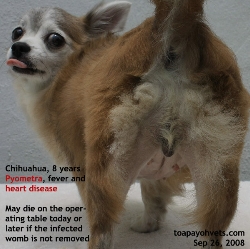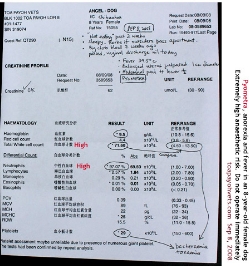|
Toa Payoh
Vets Clinical Research
Making veterinary surgery alive
to a veterinary student studying in Australia
using real case studies and pictures |
Open pyometra in an old Chihuahua
Dr Sing Kong Yuen, BVMS (Glasgow), MRCVS
Date:
06 June, 2010 |
 toapayohvets.com toapayohvets.com
Be Kind To Pets
Veterinary Education
Project 2010-0129 |
"Today may be the last
day you will see your Chihuahua alive," I said. "She has
heart disease and had one episode of heart failure
during anaesthesia two years ago during dental scaling.
She may die on the operating table."
 The
dog needed to be revived during dental scaling. I had
advised the quiet lady that the dog should not take
"further general anaesthesia". I had noted this in my
case record. Two years had passed and the dog now had
pyometra. The
dog needed to be revived during dental scaling. I had
advised the quiet lady that the dog should not take
"further general anaesthesia". I had noted this in my
case record. Two years had passed and the dog now had
pyometra.
Today, Friday Sep 26, 2008 was the day the Chihuahua was
to be operated. She had antibiotics from me for the last
5 days and had seen Vet 1 six days ago. Pyometra was
also diagnosed by Vet 1 who advised surgery and gave
antibiotics and oral painkillers.
Antibiotics given some 3 weeks ago worked to stop the
vaginal discharge. The owner was advised to get the dog
spayed after one month. But at the end of 10 days of
antibiotics, more "liver-coloured" vaginal discharge
flowed continually. The dog had no appetite and needed
hand feeding. She was losing weight and now had a
fever. Therefore she was high anaesthetic risk. A
type of case I would prefer to pass to other vets.
Passing the buck saves a lot of explanations and
unpleasantness.
Anaesthetic deaths are so unpleasant events as vets get
the blame. Newspapers loved to sensationalise the case
too. There was a recent case of a Jack Russell that died
on the operating table after being admitted for spay and
dental scaling. A
veterinarian's "stop at 8" spay policy. 3 case studies
I had not read this report but one complaint in the
newspapers was that the vet still charged his fee even
though the dog had died. No delivery of a satisfactory,
therefore no payment. Not many Singapore owners are like
that but there will be one.
 I
had spoken to the quiet lady and her husband for some
time on the 2nd recurrence of vaginal discharge 5 days
ago after cessation of antibiotics and the emergency
visit to Vet 1. Sep 8, 2008 was the first consultation
---A
veterinarian's "stop at 8" spay policy. 3 case studies I
had spoken to the quiet lady and her husband for some
time on the 2nd recurrence of vaginal discharge 5 days
ago after cessation of antibiotics and the emergency
visit to Vet 1. Sep 8, 2008 was the first consultation
---A
veterinarian's "stop at 8" spay policy. 3 case studies
Now, the problem was to determine when was the optimal
time to operate such that the dog would not die on the
operating table?
It was hard to define exactly. I advised that once the
dirty and sticky vaginal flow ceased, the dog should be
operated. The time was 5 days after antibiotics.
So the dog was here now. She has fever. Still would not
eat by herself and had lost 0.3 kg during the past 2
weeks. She still looked alert.
"I will wait at the surgery," the quiet lady said.
"It is best you go home," I said. "Waiting at the
surgery is very stressful for me in such situations of
high risk anaesthesia. I need to focus on the dog
surgery and if you are hanging around, the atmosphere is
very tense."
The lady went home. She might be seeing her pet alive
for the last time. There was no way I could be less
frank. "Do your best," the husband phoned some 30
minutes later to enquire about the dog but I had not
operated yet. His wife was very upset at the thought of
the dog not being able to be alive from general
anaesthesia.
Anaesthesia and Surgery of this high risk anaesthetic
case.
1. Dextrose saline 200 ml SC, antibiotics and anti-fever
injections given.
2. Pre-operation shaving and washing of operation done.
Let the dog rest for some minutes.
3. Gas mask anaesthesia starting at 5%. Reduce to 1.5%
after intubation. The dog was too light as she moved.
Increase to 2% but not more and wait to stabilize.
4. Incise 2 cm from umbilical scar. Make incision 2 -
3cm caudally. Hook up left uterine horn which could be
seen easily from this bigger incision. I used the
scalpel to cut the tight ovarian ligament. Ligate
ovarian blood vessel. Take out the right uterine horn
and repeat same procedure. Get the uterine body out.
3-clamp method. Ligate below clamp 3 after clamping the
horn. Ligate the crushed area after removing clamp 3.
This meant that there would be two ligations.
5. Reduce gas to 0.5% to effect. Stitched linea alba.
The dog reacted to pain. Increase to 2%. Reduced to 1%
to effect.
6. Reduced gas to 0.5% when the skin incision is
stitched. Switched off gas at the 2nd last skin
incision.
7. Dog woke up without crying, as if from a deep sleep,
after the placement of the last skin stitch.
8. Placed dog in a quiet cage. The cyanotic tongue was
not a good sign. This dog did not have sufficient
haemoglobin in her red blood cells according to a blood
test some 3 weeks ago.
9. The owner took the dog home some 1 hour after
surgery. She could care for the dog better at home.
Surgery can be
shorter if one follows the Formula One procedures. A
team where each person handles a specific task when the
sports car comes to the pit stop.
In this case, my assistant focused on the anaesthesia.
He would pinch the dog's foot to assess the presence or
absence of the pedal reflex, checked the tongue colour
and eyelid blinking. He ensured the minimal use of gas.
I focused on completing the surgery as fast as Hamilton
completed his laps to win the race in Singapore. His
competitor was Massey while mine was the death devil.
Another assistant held the forceps to lift up the
ovaries for me while I ligate to speed up work.
In this case, the dog's heart did not fail and she
recovered and went home. If she survived the next 48
hours, she should be regaining her appetite after the
toxic womb had been removed and should live a long time
as her care was excellent. As for her tartar in her
canine and other teeth, I dared not suggest any dental
scaling or did any scaling after the removal of the
womb. I don't advise such procedures although it does
save money for the owner. The shorter the anaesthesia,
the better the outcome.
What the owner wants is a
live dog at the
end of anaesthesia. Pets are family and anaesthetic
deaths are not an option.
If the vet cannot deliver, there will be much sorrow on
the part of the caregiver of the pet. Some family
members might create unpleasantness for the
veterinarian. Tabloids and internet forums love such
sensationalism.
UPDATE IN JUNE 2010
Nearly two years have passed. The beloved
Chihuahua had one breast tumour excised one year
ago. There was no recurrence. She eats well and is
active. I saw her in June 2010 because she
had generalised ringworm. The lady had applied
anti-fungal cream as prescribed by Vet 1 onto the
diseased areas but more scratching occurred under
the neck.
 |
 |
|
Cream darkens
ringworm spots |
Neck has two new
ringworm areas |
"You have no choice but to get the coat clipped
very short," I said. "The whole body hair has been
infected. Use an anti-fungal wash and oral
medication for 20 days after the groomer had
clipped the dog bald."
Anti-fungal cream is ineffective in a dog whose
whole body is infested by fungus. Consult your vet
promptly. |
|
|
 BE
KIND TO OLDER DOGS & CATS ---
GET TUMOURS REMOVED EARLY ---
WHEN THEY ARE SMALLER. More case studies, goto:
Cats or
Dogs BE
KIND TO OLDER DOGS & CATS ---
GET TUMOURS REMOVED EARLY ---
WHEN THEY ARE SMALLER. More case studies, goto:
Cats or
Dogs |
|
|
To make
an appointment: e-mail
judy@toapayohvets.com
tel: +65 9668-6469, 6254-3326 |
 toapayohvets.com toapayohvets.com
Be Kind To Pets
Veterinary Education
Project 2010-0129 |
|
|
 Toa
Payoh Vets Toa
Payoh Vets
Clinical Research
|
|
|
Copyright ©
Asiahomes Internet
All rights reserved. Revised: June 06, 2010
Toa Payoh Vets
| |
 TOA
PAYOH VETS
TOA
PAYOH VETS TOA
PAYOH VETS
TOA
PAYOH VETS